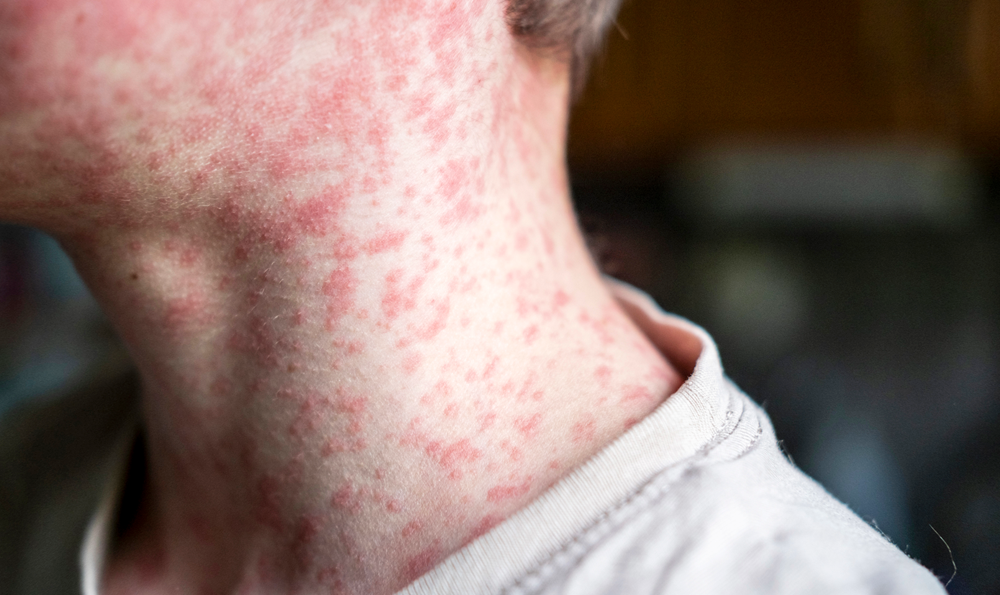Measles is a serious infection caused by a virus that easily spreads from person to person. Once a leading cause of childhood illness and death, the CDC declared the virus eliminated in 2000 because of the United States’ highly effective vaccination program. However, declining vaccination rates have led to a resurgence of the disease and outbreaks are reported in pockets across the country each year.
“Measles is one of the most highly contagious of all infectious diseases,” says Katia Camille Halabi, MD, pediatric infectious disease specialist at Atlantic Health System. “It’s so contagious that if a person with measles is in a room with 10 other people, nine of those people will become infected if they are unvaccinated.”
What is measles and who is at risk?
Also known as rubeola, the measles virus easily spreads through droplets in the air or on surfaces. Virus particles can remain in the air and on surfaces for more than two hours after an infected person coughs or sneezes.
“The measles virus isn’t just a cold, it’s a serious infection that can cause significant complications,” says Dr. Halabi. “An estimated 40% of people who were infected with measles in 2024 required hospitalization and in 2023, an estimated 107,500 people around the world died from measles. This included mostly unvaccinated or under-vaccinated children under the age of five.”
Anyone who has not had the measles vaccine or has not previously contracted measles is at risk for infection. Measles can be serious in all age groups, however, children under the age of five years, people with a weakened immune system and pregnant women have the highest rate of complications. This can include pneumonia and encephalitis (swelling of the brain), in addition to other long-term complications including a very rare but fatal disease of the central nervous system called subacute sclerosing panencephalitis. The measles virus also erases your body’s memory of previous infections in what we call “immune amnesia,” which can weaken the immune system and make you more likely to get sick from other infections.
How to protect yourself from measles
The measles vaccine, which is part of the MMR vaccine that also protects against mumps and rubella, became available in 1963 and is the most effective method for preventing infection with the virus. One dose of the vaccine is 93% effective in preventing infection, while the two doses recommended by the Centers for Disease Control and Prevention (CDC) are 97% effective.
The vaccination guidelines recommended by the CDC and endorsed by the American Academy of Pediatrics say that a child should get their first dose of the vaccine between 12 and 15 months of age, with a second dose given when a child is between four and six years old. When most of the people in a community are vaccinated, it protects people who cannot have the vaccine. However, herd immunity only happens when 95% of the population has had the measles vaccine.
“There is no doubt that vaccination is the best defense we have against measles infection,” says Dr. Halabi. “A lot of false information about the MMR vaccine has led to a drop in vaccination rates. The measles vaccine has been studied in-depth and is safe and effective for children and adults.”
Dr. Halabi says that two doses of the vaccine should provide lifetime immunity from the measles virus. You should not get the MMR vaccine if you are pregnant or if you’ve had a severe allergic reaction to a previous dose or a vaccine component. The vaccine is also not recommended for people with a weakened immune system from organ transplant or treatments such as chemotherapy, radiation or immunotherapy. If you are unsure about your vaccination status, talk with your provider to determine if a booster or blood test is appropriate.
The signs and symptoms of measles
Dr. Halabi explains that early symptoms of the measles virus can be confused with other conditions, such as the common cold. Symptoms typically appear eight to 12 days after infection and can include the following:
- Fever
- Cough
- Red, watery eyes
- Runny nose
In the later stages of infection, a rash typically appears and is a key symptom of infection with the measles virus. The rash typically shows up two to four days after the first symptoms. It usually begins as flat red spots near your hairline and it spreads downward to your face and then the rest of your body. Dr. Halabi says the rash is typically not itchy and appears red on light complexions, but the color can vary depending on a person’s skin tone.
If you have recently traveled outside the United States, have not been vaccinated or live in a community where an outbreak has been identified, it’s important to discuss your symptoms with your medical provider so they can evaluate you for measles infection.
“The MMR vaccine is safe and effective and the best and only way to prevent measles and its complications. It is sad to see such a preventable disease spread,” says Dr. Halabi. “Please make sure to have a discussion with your doctor and ask for reliable resources to learn more about measles and vaccines. We can prevent this and keep everyone safe.”






